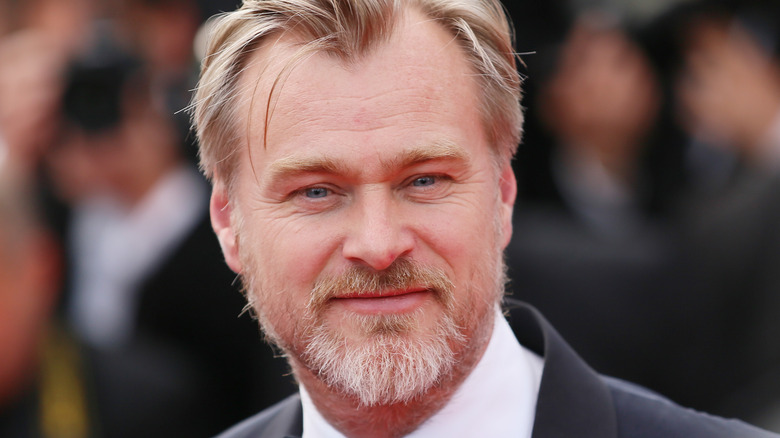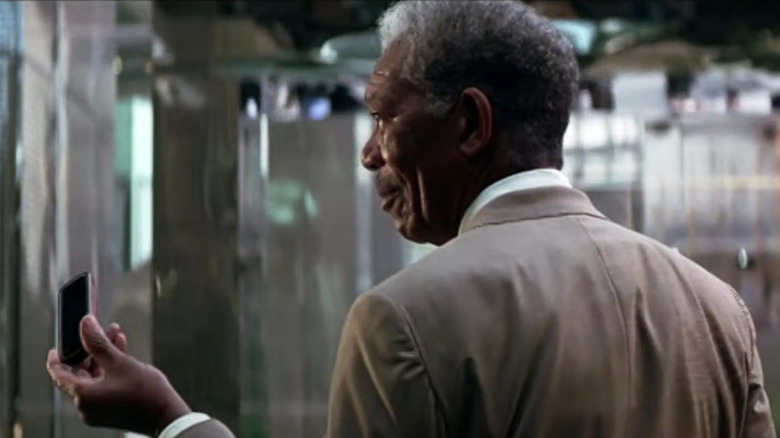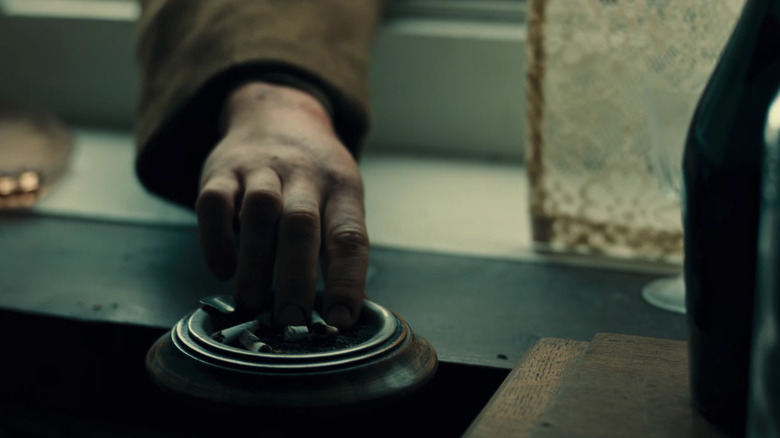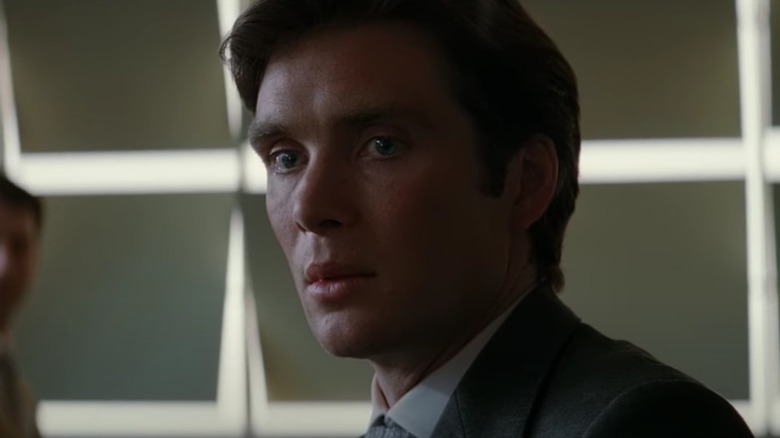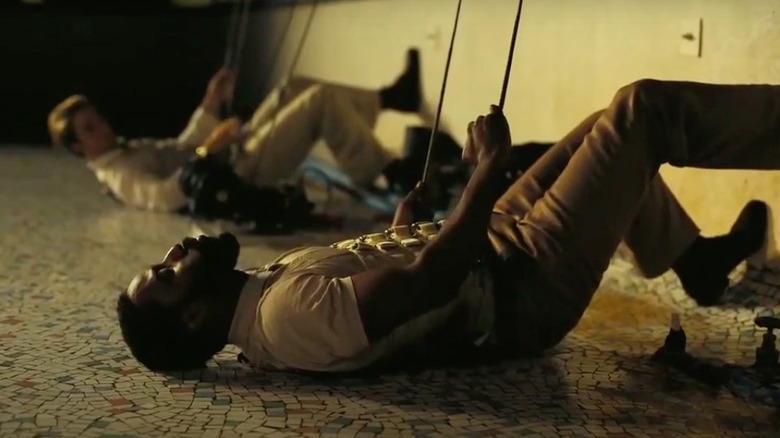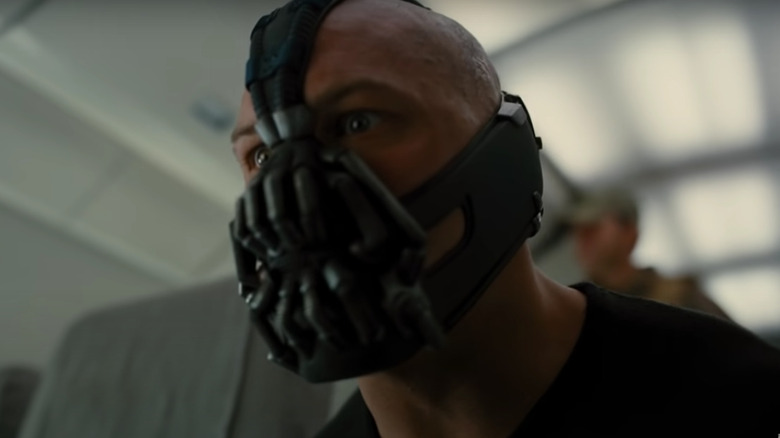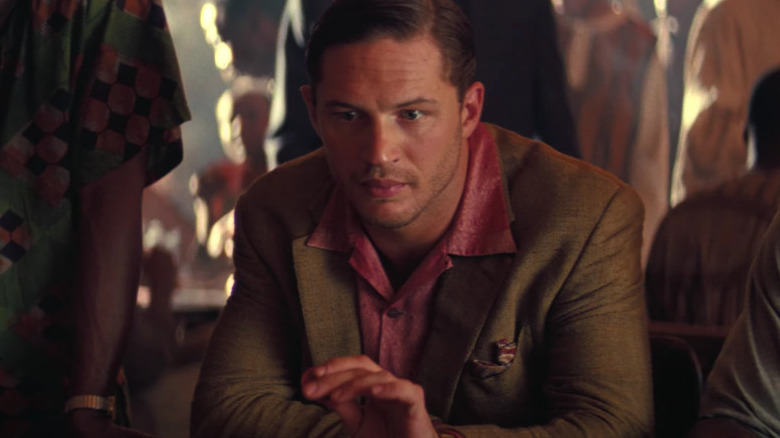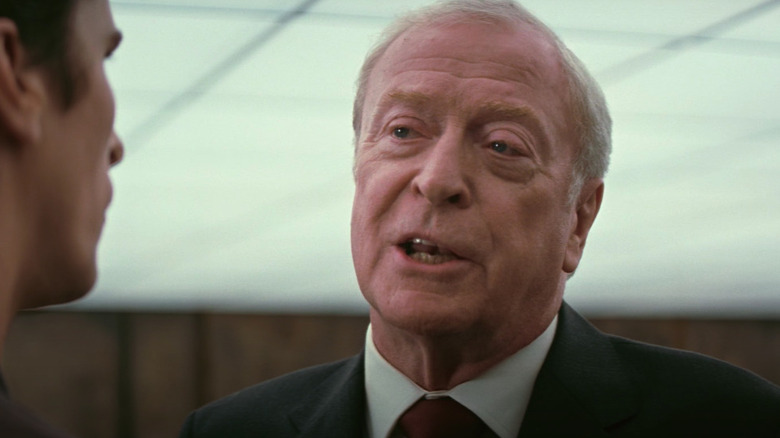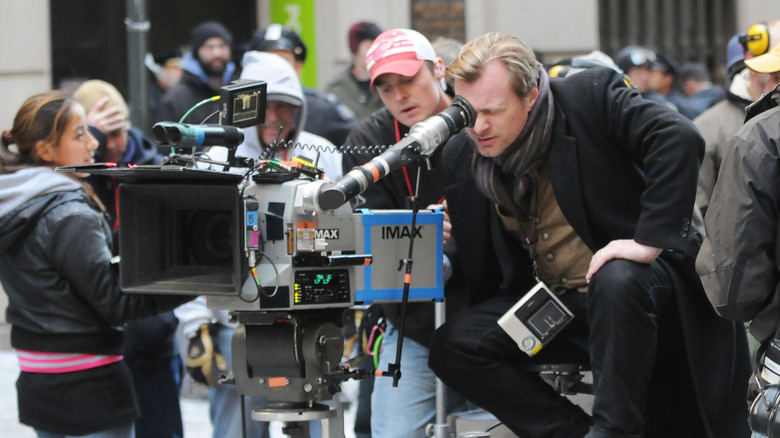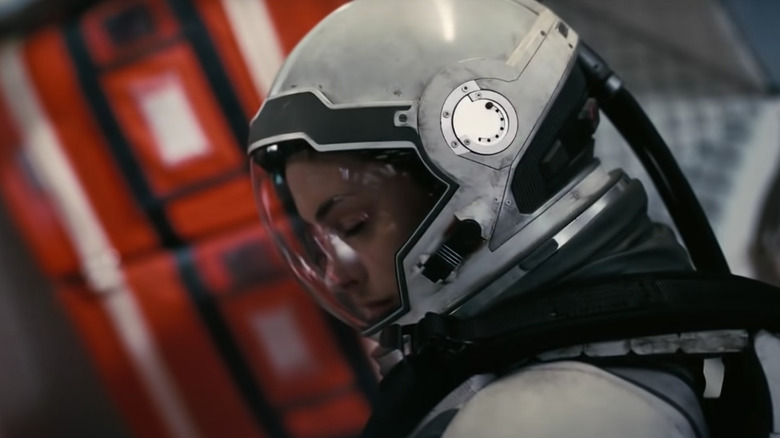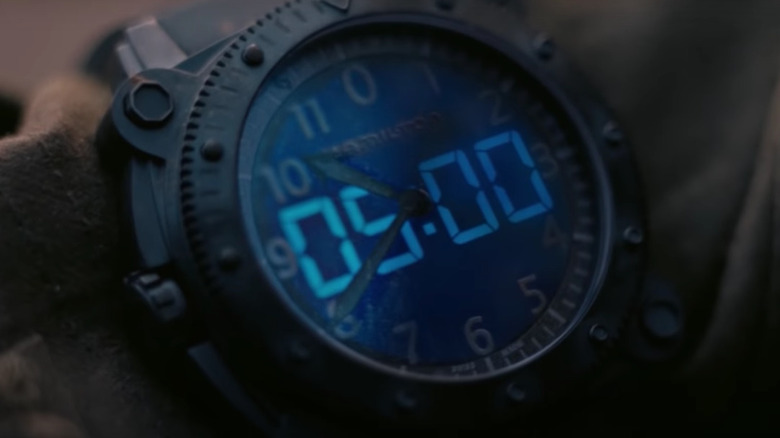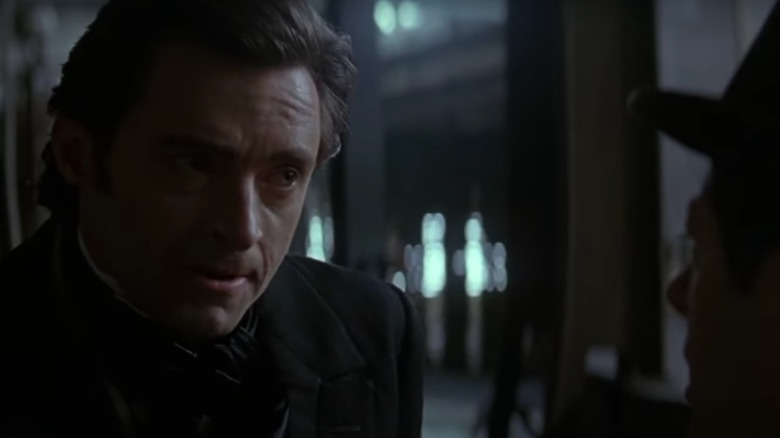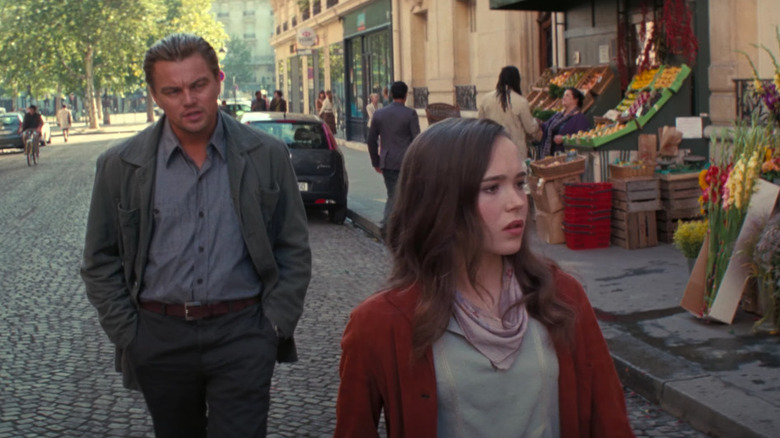Rules Actors Have To Follow In Christopher Nolan Movies
Christopher Nolan has become one of the top auteurs in Hollywood, in large part because of the fiercely original, stylistic flair that he has infused into such classic crowd-pleasers as "Inception," "Interstellar," "Memento," "Tenet" and the "Dark Knight" trilogy. His films are increasingly, unfortunately a rarity: Meticulously crafted, expertly assembled, challenging to audiences, yet profitable.
All told, Nolan's films have accrued over $4 billion at the global box office, driving a desire for Hollywood's biggest names (DiCaprio, Bale, McConaughey) to work with him. But ultimately, when it comes to a Christopher Nolan film, no name is a bigger draw than his.
Like Scorsese and Tarantino, over decades in the industry, Nolan has developed some intriguing behind-the-scenes habits that drive his unique sets; many have come to light over the years, via interviews with actors and crew members. So, what rules must the actors in a Christopher Nolan follow when they are a part of one of his massive, intensely-secretive productions? Like one of the patented twists found in his movies, read on to uncover some mind-blowing revelations.
No cell phones allowed
Imagine trying to tell Leonardo Di Caprio that he can't take a call from his agent, or Robert Pattinson that he needs to stop playing Wordle. Believe it or not, like Morgan Freeman's Lucius Fox taking a meeting in Hong Kong, actors on a Nolan set are subjected to a strict "no cell phone" policy.
Nolan apparently feels the smart devices interrupt or distract from the work itself.
"There's a mass belief that if you're texting, you're somehow not interrupting the conversation — you're not being rude. It's an illusion of multitasking," Nolan said to Esquire in 2017. "I started filmmaking when people didn't expect to have a phone on set, when it would've been seen as unprofessional to pull out a phone. Phones have become a huge distraction, and people work much better without them. At first it causes difficulty, but it really allows them to concentrate on what they're doing. Everybody understands. I've had a lot of crews thank me. With a set, we're trying to create a bubble of alternate reality."
Ultimately, he explained, if you're giving even one percent of your attention to a call, text, app or TikTok video, it's too much.
"The person doing it doesn't realize they have taken the energy from the conversation. If you have people in a creative environment where they have to concentrate on what they're doing, you can't have them wandering off in their minds. You can't be texting somebody else and paying attention to what's going on," he said. "If you call people on it, they'll repeat the last thing you said. They repeat the words with zero understanding of what they meant. And then over the next minute, you see them start to understand the words for the first time. You can absorb audio information just at the level that you can repeat it back, without understanding."
Keep your cigarettes in your pocket
Actors working with Nolan need to learn how to get through his massive productions without the aid of nicotine, as the director doesn't allow cigarettes on his sets. This detail emerged in a 2020 statement that had the filmmaker addressing rumors that he had banned chairs from his sets. So, to be clear: Christopher Nolan will let his actors park their butts, as long as they don't try to smoke one.
"For the record, the only things banned from sets are cell phones (not always successfully) and smoking (very successfully)," Nolan's spokesperson, Kelly Bush Novak of ID said in the statement, a response to Anne Hathaway comments about Nolan discouraging chair traffic jams near video village, which were misinterpreted.
But back to cigarettes, of which Nolan doesn't seem particularly fond, even if characters in his films can be seen smoking them — in fact, the very first image from his upcoming, star-powered biopic "Oppenheimer" featured Cillian Murphy dangling one from his mouth (in real life, atomic bomb creator Robert J. Oppenheimer was known to smoke 100 cigarettes a day). Conversely, some have pointed out that the soldiers in "Dunkirk" didn't smoke enough.
Even if Murphy spends the entire runtime of "Oppenheimer" chain-smoking like Tom Snyder in a '70s talk show clip, it can be safely assumed that he was asked to visit the ash tray once Nolan called "cut."
A little confusion comes with the territory
Christopher Nolan loves to befuddle his audience with complex plots that sometimes require diagrams to decipher. Sometimes, the director's puzzles prove too baffling even for the actors participating in them, as was the case when Guy Pearce first read the script for "Memento."
"Even though on some level it felt like gobbledegook as I was reading it," Pearce told IndieWire in 2020, "what I really got and what was really clear was the emotional journey of the character. As the actor, that's the only thing I need to latch onto in order to do my job. The other stuff began to make sense more as I worked with Chris Nolan."
Similarly, DiCaprio admitted he was confused by the mind-bending plot of "Inception," particularly its famous, open-to-interpretation ending.
"What happened? I have no idea," DiCaprio said on the "WTF with Marc Maron" podcast in 2020. "Sometimes, you're just focused on your character, man."
More recently, the cast of "Tenet," including lead actor John David Washington, revealed they bombarded Nolan with questions about the film's intricate time travel plot on the regular. "Every day I had questions for him," Washington told ComicBook.com upon the film's release. "But he was very gracious, and he answered them very calmly and patiently."
Prepare for a lot of practical VFX
It's well known that Nolan is among a breed of old-school filmmakers who prefer theatrical to streaming, celluloid over digital, and practical effects over CGI. Even on colossal productions like "The Dark Knight" and "Inception," he sidesteps CGI whenever possible, often achieving his jaw-dropping visuals with inventive, in-camera trickery.
On "Tenet," Nolan's 2020 mind-bender about moving backwards through time, stunt double Daniel Graham explained to Metro.co.uk how the astounding fight sequences required "grueling work from the stunt performers."
"It's not like Marvel; Marvel does CG and even when it looks real, it's still a little CG-ish," Graham said. "[Nolan] likes to do everything realistic." Graham, who doubled for John David Washington, explained that he was forced to learn how to fight backwards to achieve the film's astonishing visuals.
"The visual side of the film is huge in scale," Nolan told ICG Magazine, the official publication of the International Cinematographers' Guild. "but our VFX shot count is probably lower than most romantic comedies."
It is estimated that "Tenet" had fewer than 300 visual effects shots. For comparison, "Avengers: Endgame" had over 2000.
Be prepared to keep secrets
Working on a Nolan film, it seems, is something akin to working for the CIA. When somebody asks you what you did at work today, you'd better have a cover story.
Nolan goes to such lengths to keep spoilers from leaking to the general public that "Tenet" actor Michael Caine told IndieWire in 2020 that he had no idea what the film was about — because Nolan wouldn't give him a script. "All I had was one day's work and he gave me my pages. I did my part and shot only with John David [Washington]. I haven't heard anything since."
If an actor does get the luxury of reading an entire Nolan script (he has a hand in writing nearly every one of his films), they are sworn to utmost secrecy. In 2011, Anne Hathaway told Total Film: "I signed a blood oath [to play Catwoman in 'The Dark Knight Rises']; Bloody thumbprint on the paper."
Likewise, the cast of "Interstellar" were instructed to not discuss any specifics about that film's plot outside a few general statements.
"I've never been so scared in my life," Bill Irwin, who voiced one of the film's robots, told The Hollywood Reporter in an amusing anecdote about accidentally leaving a copy of his script in a supermarket. "I set my script down once at Ralphs grocery store in L.A., and I walked away from it for maybe all of three minutes."
Another funny "Interstellar" moment occurred when John Lithgow went to dinner with David Oyelowo, who had small part in the film and had just finished shooting. "They had not told him the story of the movie he was in," Lithgow recalled. "We went out to supper and he told me he didn't know, so for 20 minutes I told him the plot of the film, and his jaw dropped open. His eyes were like saucers, and he said, 'My God, I am in such a great movie.'"
Expect to dress like a magazine model
Much like Sam Raimi, Nolan adheres to an on-set dress code that harkens back to the days of Alfred Hitchcock. Alongside the likes of Paul Feig and Tom Ford (naturally), he might be one of the most stylish filmmakers around ... behind, and in front of the camera.
The same can be said for the look he projects in his frame. Leonardo DiCaprio's Dom Cobb famously hijacked dreams in "Inception" whilst wearing everything from wide lapel two-piece suits and broadcloth shirts with elongated straight point collars to a dark navy plaid flannel shirt ... and brown jacket. Christian Bale's Bruce Wayne enjoyed two-button Armani suits in "The Dark Knight," while the protagonists of "Tenet," namely Washington and Pattinson, employed custom fit suits like something out of a classic James Bond film.
Female characters are just as glamorous, with the likes of Elizabeth Debicki and Marion Cotillard adorning lavish dresses that reflected their characters' emotions. Even the side characters of the WWII epic "Dunkirk," played by Mark Rylance, Barry Keoghan and Tom Glynn-Carney, looked like models ripped from the cover of Vogue with their stylish sweaters and pullovers.
Chances are, you'll meet Sir Michael Caine
Caine has been a fixture in Nolan's films since the pair first worked together on 2005's "Batman Begins" — a role that took some convincing for the beloved actor's participation.
Reflecting on their first meeting about the role of Alfred, Caine told Variety in 2021: "He said, 'Can I come in?' And he said to me, 'I want you to play the butler in 'Batman.' So, I said, 'The butler? What do I say, 'Dinner is served?' He said no, he was the godfather of Batman and it's a much bigger part. That was the first thing I remembered about Christopher Nolan."
Since then, Nolan has featured Caine in nearly all his films. He played a substantial role in "The Prestige," reprised his role as Alfred in "The Dark Knight" and "The Dark Knight Rises," popped in for a cameo in "Inception," had an extended role as a scientist in "Interstellar," supplied his voice for an unseen pilot in "Dunkirk," and appeared in a minor bit to drop some heavy exposition into "Tenet."
Much like John Ratzenberger with Pixar, Bruce Campbell with Sam Raimi, Owen Wilson with Wes Anderson or Samuel L. Jackson with Quentin Tarantino, it feels like a given — if not a running joke — that if you buy a ticket to see a film by a certain filmmaker, a particular actor will pop up in there somewhere. In other words, if you're an actor looking for a chance to work with the great Sir Michael Caine, be sure to answer your phone when it says "Nolan" on the caller ID.
Expect to work with the same behind-the-scenes crew
Much like how he treats actors, Nolan remains fiercely loyal to his behind-the-scenes crew. When the filmmaker finds someone he likes, he tends to stick with them, giving his films a unique feel and a streamlined production aesthetic, populated by artists who understand and support his vision from one production to the next.
This extends to everyone from production designer Nathan Crowley, cinematographer Wally Pfister, editor Lee Smith, casting director John Papsidera, composer Hans Zimmer, and sound designer Richard King — all of whom have worked on the majority of Nolan's productions. In the acting department, along with Caine, the same can be said for Tom Hardy, Bale, Hathaway, Murphy, Kenneth Branagh, and Joseph Gordon-Levitt.
This isn't to say that Nolan is hesitant to new faces. Early in his career, he worked with editor Dody Dorn on "Memento" and "Insomnia" and composer David Julyan on his short works, namely "Larceny," "Doodlebug" and his debut film "Following," among others. Nolan also leapt to cinematographer Hoyte von Hoytema following Wally Pfister's graduation to director.
Don't stress on set
As meticulous and prepared as he may be in his work, by all accounts, Nolan is a chill guy. He rarely loses his temper, and manages to make the best out of unfortunate situations.
In a visit to the set of "Inception," for example, Empire Magazine writer Dan Jolin recalled a moment where the special effects team failed to destroy a building properly, botching a one-take opportunity that likely cost the production a not-insignificant amount of money. Nolan was undeterred. Rather than lose his temper, he merely shrugged off the incident.
"It did not go quite as planned," he told Empire Magazine of the incident, "but we're still using the shot." He had planned to use a miniature even if the effect had gone properly, and was able to salvage snippets of the shot in the final film.
The director certainly demands the best from his crew; his productions tend to be difficult due to their immense scale, aforementioned practical effects, grandiose locales, and technically challenging action sequences. Through it all, he maintains a calm, professional demeanor far removed from the likes of, say, James Cameron or Michael Mann.
"I've been on six Nolan sets during the past 12 years, for four of his films, and I've never once seen him flustered," Jolin wrote in 2020, adding he had only once seen the filmmaker react with concern, on the set of "The Dark Knight Rises," in the middle of a scene that involved 1200 extras and a swirling snow squall.
"[With] a whopping IMAX Steadicam whirling around them, were Christian Bale and Tom Hardy trading blows in full superhero and villain costume. Nolan stood nearby, watching intently, when Bale suddenly stumbled backwards in his direction," the writer recalled. "It's the fastest I've ever seen Nolan move, dodging out of Batman's way. But still, he didn't even spill his tea."
Be punctual and love watches
Time remains a constant theme throughout Nolan's impressive body of work. Whether it be the non-linear storytelling of "The Prestige," backwards script of "Memento," loss of moorings in "Insomnia" or the intricate dream-within-a-dream time heists of "Inception," Nolan explores the concept of time in some way with each and every one of his motion pictures.
This obsession lends itself to tiny character details, such as the wristwatches worn by heroes like Cobb in "Inception" and the unnamed Protagonist in "Tenet." A pivotal scene in "Tenet" between the Protagonist and Caine's mysterious British Intelligence Officer revolves around the main character's appearance — his suit and accessories — which require an upgrade if he is to properly deceive Branagh's rich megalomaniac later in the film. As such, in the next scene we see the Protagonist sporting a Hamilton Jazzmaster Seaview Chrono Quartz, while the villain dons a Hamilton Khaki Navy BeLOWZERO. For watch nerds, this is a true geek moment; for everyone who just checks the time on their cellphone, it is perhaps a detail unappreciated.
Other examples include the CK2129 Tom Hardy wears in "Dunkirk" and the Jaeger-LeCoultre Reverso Grande Taille and Reverso Grand Date Christian Bale flashes in "The Dark Knight" trilogy; time (and how the character chooses to monitor it) is an aspect of Nolan's character that has seeped itself into every one of his pictures.
"He's unfailingly punctual — like, unbelievably punctual. And it's really quite noticeable," explained film critic and "The Nolan Variations" author Tom Shone in a 2020 interview with InsideHook. "The emotional aspect of time passing, which is something that we all feel, is something that his films are really plugged into as well."
Get accustomed to acting in the shadows
Actors joining a Nolan production should brace themselves for shadow. Lots and lots of shadow. While Nolan employs time-tested techniques to tell his stories, he loves to bathe his characters in ominous darkness, often as a way of highlighting their hidden agendas or darker personalities.
As explained in a 2020 piece by The Beat, many Hollywood productions lean on a technique known as "Hollywood" key light, where the subject's face is mostly lit but the lighting still casts softer shadows. Nolan takes things one step further, creating a strong contrast between one side of the character's face and the other. "Rather than light both sides of the face with his keylight, Nolan's signature style is to have the keylight just catch the near-side eye so that three-fourths of the face is in shadow," the site observed.
This style is particularly noticeable in "The Dark Knight," where Nolan hints at Harvey Dent's impending "Two Face" personality by draping one side of the character's face entirely in shadow during an intense interrogation sequence. In "Inception," Mal's face is adorned with the same sort of lighting right before her "leap of faith." Ditto for many of the soldiers in "Dunkirk," all of whom engage in deplorable violence — capitulating to their dark side, if you will — in order to survive.
Prepare for long takes on location
Nolan actors must be prepared to leave the cozy trappings of the Hollywood backlot (and warehouses with green screens) behind for complicated shoots on actual locations.
Since Nolan prefers traditional techniques, and would rather set his cameras up in downtown Pittsburgh than build a post-production city via CGI, it gives the actors a (increasingly rare) opportunity to touch, smell and feel their environs. For "Inception," Nolan led his crew to Kananaskis, Alberta in the middle of winter to shoot the film's action-packed finale. For "The Dark Knight," the director moved the sequel into the mean streets of Chicago; the grand finale of "The Dark Knight Rises," meanwhile was filmed on the steps of the Carnegie Mellon Institute in the Steel City.
While filming on location can lead to difficulties, few can argue with the end result. Nolan's choice to turn Chicago into Gotham City gave it a grittiness that fueled such classic moments as the "Dark Knight" opening robbery scene, while the Paris backdrop of "Inception" lends an undeniable polish to its dreamscapes. In this age of endless CG spectacle — films that achieve the impossible via their use of computer effects — his films stand out, ironically defiant because Nolan goes the extra mile to keep his fantastical tales grounded in his rules of reality.
